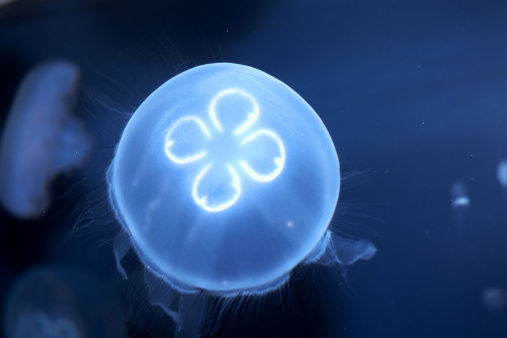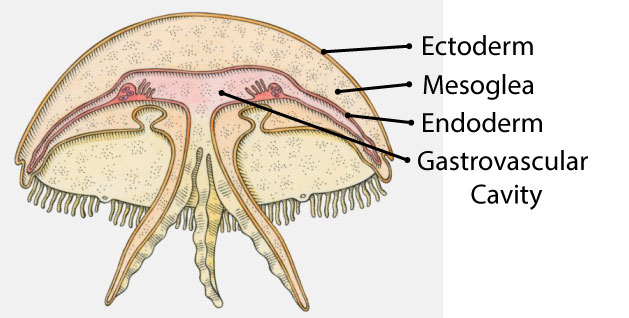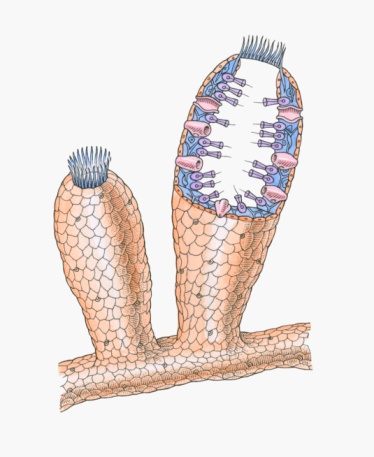Although cnidarians appear to be rather simple animals, there are some important ways their bodies are more advanced than that of their predecessors, the sponges. Scientists believe that the complexities of cnidarians are an important jump in the evolution of all animals and are traits that are present in all animals that you will learn about in the next few lessons. In the activity below, click the tabs to learn about the advancements in cnidarian bodies.
Symmetry
Tissue
Extracellular Digestion

Recall that symmetry is a characteristic of all complex animals and indicates a high degree of organization. Do sponges have symmetrical bodies? Think of the answer, then click "Show Me" to see if you are correct.

No. Sponges have asymmetrical bodies.
Cnidarians have radially symmetrical bodies. Cnidarians have a specific and exact arrangement of their body parts, like the spokes on a bicycle wheel or the petal arrangement in daisies.

The tissue layers of cnidarians are evident in this diagram of a jellyfish.
Recall that a group of cells doing a specific task together is organized into tissue. Although sponges have different types of cells with special jobs, the jobs do not have the high level of coordination required to be considered tissue. What are the three cell types in sponges? Think of the answer, then click "Show Me" to see if you are correct.

Sponges are composed of choanocytes, amoebocytes, and epidermal cells.
Cnidarians, on the other hand, are composed of highly organized tissue. There are two layers of tissue that make up Cnidarian bodies--endoderm and ectoderm. Sandwiched in between these two tissue layers is mesoglea, which is a jelly-like substance that holds together the cnidarian body. The ectoderm layer composes the entire outer surface of the cnidarian. The endoderm lines the gastrovascular cavity.

The purple flagellated cells are the
choanocytes that capture food in
sponges.
Sponge food can be no
bigger
than these
individual cells.
![By Marymegan Daly, Frank Rack, Robert Zook [CC-BY-2.5 (http://creativecommons.org/licenses/by/2.5)], via Wikimedia Commons](https://s3.amazonaws.com/cms.accelerate-ed.com/image/e23a4664-46ad-47df-9b1a-e32c39a27a95.jpg)
Pictured is a cross section of a sea
anemone
with the gastrovascular
cavity.
Cnidarians are different in how they digest their food. Sponges digest their food intracellularly (inside their cells), whereas cnidarians digest food extracellularly (outside their cells) in their gastrovascular cavity. This particular advancement is very important to all animals that evolved after cnidarians.
Recall that sponges capture their food with the cells lining their internal cavity. What are these cells? Think of the answer, then click "Show Me" to see if you are correct.

Choanocytes are the sponge cells that capture food.
After the food is captured, the choanocytes take up the food (remember, sponges eat microscopic organisms) and digest it right inside the cell. This means that sponges can only eat food that is the size of their individual cells, or smaller. Unlike sponges, cnidarians can eat and digest food that is a lot bigger than their individual cells. This is because they have a gastrovascular cavity, as do all animals that evolved from cnidarians. The endoderm tissue layer that lines the gastrovascular cavity releases digestive enzymes that break down the food inside the tissue-lined cavity. After the food is in small enough pieces, the cells lining the gastrovascular cavity take up the nutrients.
Test your knowledge of cnidarians by completing the activity below.
| Use the dart to pop any balloons that contain cnidarian attributes or characteristics. |
Complete
